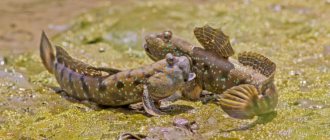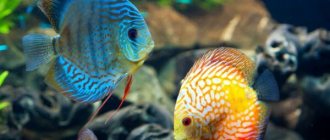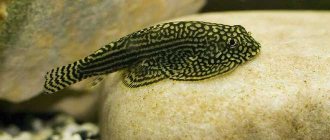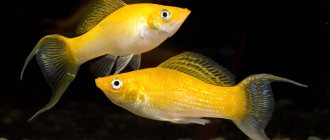Argus scatophagus is a large aquarium inhabitant. In Latin, the name of this fish sounds like Scatophagus argus. The generic name Scatophagus literally translates to “sewage eater.” The fact is that argus are often found near floating toilets in reservoirs in southeast Asia. It is not entirely clear whether they feed on excrement or simply eat the living creatures that are in these places, but when keeping argus in an aquarium, there are no problems with feeding them.
Scatophagus was first described by Carl Linnaeus in 1766. They are most often found in the waters of the Pacific Ocean. The fish that you see in pet stores are caught in the vicinity of Thailand. They live in estuaries of rivers flowing into the sea, flooded mango groves and small rivers of the coastal strip. They eat insects, small fish, larvae and plants.
— Advertising —
The body of the argus looks like a square, with a steep forehead protruding at the head. In the wild, these fish grow to almost 40 cm; aquarium specimens are smaller, only 15-20 cm. In an aquarium, scatophagus can live up to 20 years. The main body color is bronze-yellow. Young fish have a rounder body; with age, individuals acquire a square outline. A peculiarity of the species is the presence of spines on the body - 11 of them are located in the dorsal fin of the fish, 4 - on the fin near the anus, and one each - in the abdominal fins. The owner should be careful - injections of argus thorns are very painful and heal slowly.
Requirements for an aquarium
In order for the argus to live comfortably, it is necessary to provide it with space for swimming. Argus are rather large fish, therefore the aquarium should be large. To keep argus, you need to purchase an aquarium with a volume of at least 200 liters. A straight and rectangular aquarium is best in shape; a round container of this volume will be too bulky. The aquarium must be equipped with a compressor and filter.
Compatibility
Argus has a fairly calm disposition, and in a large aquarium it can get along well with fish of various sizes. It is undesirable to keep her alone for a long time, otherwise the argus will become timid and nervous. The best option is to keep schooling argus in a group of 5-6 pieces.
Argus have good compatibility with mangrove perch, monodactylus, and mudfish. And it can eat neighbors that are too small.
Scatophagus is not afraid of people and is able to eat from hands, behaves calmly and trustingly.
Acceptance of fresh and salt water made the argus an excellent option for those who have not decided on the choice of an aquarium based on the composition of the water, since it is a universal specimen. This aquarium fish looks fun in the aquarium thanks to its entertaining habits and interesting body pattern.
Water requirements
— Advertising —
To fill the aquarium, use settled water of medium hardness. Argus are inhabitants of southern reservoirs, therefore the water in the aquarium should be at a higher temperature. The optimal temperature for argus is from 20 to 32 degrees. As the fish grow, the aquatic environment in the aquarium must be salted. To ensure the required salt concentration, add at least 6 grams of sea salt for every liter of water. It is necessary to regularly replace part of the water, because argus react sharply to an increase in the concentration of nitrogen compounds.
Habitat
Originates from coastal waters of the Indo-Pacific region.
The habitat ranges along the coast of India, from southern Japan, the archipelagos of Indonesia and the Philippines to northern Australia. The fish is found in sea, brackish and fresh water, inhabiting flooded mangrove forests, estuaries (where rivers flow into the sea) and lower reaches of rivers. Brief information:
- Aquarium volume - from 1000 liters.
- Water and air temperature - 25–26°C
- pH value – 7.0–8.5
- Water hardness - medium to high hardness (10–25 dGH)
- Substrate type - sandy, silted
- Lighting - moderate, bright
- Brackish water - yes, in a concentration of 5–10 g. for 1 liter of water
- Water movement - weak, moderate
- The size of the fish is about 35 cm.
- Nutrition - plant foods
- Temperament - peaceful
- Keeping in a group of 4–5 individuals
Breeding Argus
Argus are spawning fish. But cases of their breeding in aquarium conditions have not been described.
Under natural conditions, argus lay eggs in the coastal zone. After birth, the fry move to areas with fresh water, where they fatten and grow. As adults, argus return to salt water. It is not possible to recreate such breeding conditions in a home aquarium.
Maintenance and care, arrangement of the aquarium
It is considered a fairly unpretentious species, capable of adapting to various water conditions if they change gradually. A small group of fish will require a tank of 800–1000 liters. The design is arbitrary and is selected at the discretion of the aquarist. For example, if you wish and have the opportunity, you can recreate a section of mangroves. Although living plants will decorate the aquarium, they will not last long, as they will be eaten. Successful keeping of Argus fish depends on maintaining high water quality. The main burden falls on the filtration system, but do not forget about regular maintenance procedures. Weekly replacement of part of the water with fresh water and removal of organic waste are mandatory.
Argus diseases
Argus are distinguished by good resistance to various kinds of diseases. The owners of these fish note that scatophages are the most tenacious of the known species living in salt water. The possible deterioration in the health of these creatures is explained by the low salt content in the water. If alarming signs appear, add some sea salt to the aquarium.
Feeding
The fish's diet includes literally everything that comes their way. For healthy development, you can feed with spinach, lettuce, cabbage leaves, dandelion and nettle. Plant foods should make up a quarter of their food volume.
Among live foods, it is better to give preference to high-quality seafood, grated cheese, bloodworms, and beef. Argus eats a lot and you don’t have to worry about overfeeding him.
Character and features
The main advantage of scatophagus is its peacefulness, which competes with the enormous appetite of these fish: they eat everything that comes into the field of view of their expressive eyes. The gluttony of these fish is simply fantastic: they absorb all food, without particularly understanding the quality, and do not even disdain the excrement of their fellow species. Thus, the argus can perfectly coexist with large cichlids, or other fish large enough to be accidentally swallowed. Algae are destroyed by scatophagus immediately, so for the internal equipment of the aquarium it is best to choose plastic bushes, snags and grottoes.
These fish really love leaf lettuce, and in general, plant components should make up at least half of their diet. The aquarium fish Argus is a schooling creature, it must
But you need a company of your own kind, so five or six fish usually frolic happily in the aquarium. Skatophagus is almost not afraid of humans, it is perfectly accustomed to eating from hands, does not hide and does not rush around the aquarium. Children love these fish for their interesting habits and gullibility. Argus has excellent digestion, so there is practically no risk of overfeeding them.
Argus species
There is not much information about species of the genus Scatophagus. Basically, there are two most famous species: green speckled argus and red-backed argus.
Argus mottled green
Green speckled argus (Scatophagus argus) is the most typical representative of this genus. Its name is often used to describe all argus. The second name of the species is spotted argus. Externally, the fish is beautiful - dark spots are scattered across its bronze body. In an aquarium it grows up to 20 cm.
By nature, these are peaceful schooling fish that combine well with other types of aquarium inhabitants. But, if they are hungry, they can feast on smaller fish.
Both fresh and salted water are suitable for keeping this species. Under natural conditions, they settle in river mouths with variable salinity.
Argus redback
Redback argus (Scatophagus rubrifrons) is another popular argus species. It is also called red argus. On the forehead and front of the back the fish has a red spot, which can be continuous or consist of separate spots. As the fish grow older, their coloration fades and the spots become blurry. Sometimes the spots merge and stripes are formed, different in width and color.
In an aquarium, the fish can grow up to 30 cm in length.
To keep adult individuals, salted water is required (sea salt additives are used).
Description
Adults reach a length of about 35 cm. The profile of the fish has a “quadrangular” shape, strongly compressed from the sides and a small protruding head. The dorsal fin is divided in two, its first part is located on top and has sharp poisonous spines. In a calm state, this part of the fin is pressed to the body. The second part, together with the anal fin, is back closer to the triangular tail. This body shape helps the fish squeeze into narrow crevices in search of food. Juveniles are greenish-brown with rows of diagonal dark stripes and numerous speckles. As they grow older, the color becomes silver, the stripes disappear, and only round spots remain.
Appearance
This is a fairly large fish, its length can reach several tens (up to 30) centimeters. The color is quite contrasting. If you are satisfied with the slightly gigantic size of these fish for the aquarium world, argus will look great inside a large, roomy aquarium.
The minimum aquarium size is 150-170 liters per pair of argus.
Video. Argus in the aquarium:
It is best to keep 6-7 fish in one aquarium. Water for argus needs clean and not stagnant, i.e. Water should always be kept fresh. They inhabit river deltas, where fresh water is mixed with sea water. Fry are often found even in very fresh water. They live in flocks and feed mainly on plants. Since they can consume green food in very large quantities, and this is related to their metabolism and digestion and does not contribute to the purity of the aquarium water, it is therefore necessary to stock up on a powerful filter.
If, of course, the aquarist can afford to often buy aquarium flora anew and disturb the fish by constantly replanting plants, you can also plant live plants in an aquarium with argus.
Keeping in an aquarium
For a comfortable existence of argus in a home aquarium, it is necessary to provide free space. Therefore, select a spacious container - at least 200 liters in volume. It is equipped with a compressor and a filtering device.
Optimal conditions of the aquatic environment:
- temperature 24-28 C;
- hardness 10-25 dH;
- acidity 7-9 pH.
Can be kept in a brackish or even freshwater aquarium. It is recommended to add salt to the water at the rate of 2-3 tablespoons of sea salt per 10 liters. The water volume is systematically replaced, since argus is extremely sensitive to increased nitrogen content.
The interior space is decorated with driftwood, rocky grottoes and other decor. Vegetation is not desirable, as the argus will quickly deal with it. Sand or pebbles are poured onto the bottom.
Difficulty in content
Keeping argus is only possible for experienced aquarists, due to a number of nuances. Young fish live quietly in a fresh environment, but as they age, their need for saltiness increases. Such a regime change requires certain skills from the owners.
In addition, argus grow very large, which forces them to purchase an impressively sized aquarium. And this means problems with finding an acceptable location in the house. Another nuance is the poisonous spines. The fish should be handled with extreme caution, as the injection site is very painful.
Compatibility with other fish
Argus is a sedate fish by nature and does not show aggression towards nearby swimming neighbors without reason. Prefers a gregarious lifestyle. So they release 4-5 individuals into the aquarium.
Stable compatibility of Argus with representatives of a similar character and similar size was noted. They perceive small fish as prey and eat them.
Peculiarities
These fish have the distinctive feature of eating everything, in honor of which they got their name “sewage absorber”. Argus is capable of absorbing both any type of food and fish excrement. It is advisable to install artificial plants, since Skatophagus likes to gnaw leaves and roots of plants, as well as algae. On the one hand, this is a rather unpleasant quality, but on the other hand, these fish are good at cleaning the aquarium from dirt and impurities.
Skatophagus cannot reproduce in captivity, as it is accustomed to spawning in natural habitats, migrating to rivers. Therefore, the argus that go on sale are caught from natural conditions.
Scatophagus can live up to 20 years if well maintained.
Return to content
Features of maintenance and behavior in a decorative aquarium
Young argus can be kept in a freshwater aquarium, but as they grow older, the salinity of the water should increase (Decorative saltwater aquarium). Argus can eat plants, so some living plants need to be replaced with artificial ones. Decorations must be firmly fixed. Argus are sensitive to nitrite and nitrate content; it is necessary to regularly change the water and wash the filter. Large Argus can sting with small poisonous spines in the front part of the upper fin, which causes severe pain and dizziness; it is necessary to immerse the damaged area of skin in hot water for a while.
Argus spotted "Scatophagus"
Don’t be surprised, but or speckled Argus are sea fish with an indecent name. The fact is that they have a habit of hanging around floating toilets that are being built in Southeast Asia. No one knows for sure whether the Argus eat the contents of these structures or still feed on various creatures that live in such “grain places”. However, they received the Latin name Scatophagus , which, in fact, means “excrement eater.”
Conditions of detention
- Latin name: Scatophagus argus
- Russian name: Argus spotted "skatophagus"
- Origin: Southeast Asia
- Common sizes: in captivity up to 20 cm
- Habitat layer: center
- Acidity pH: 7.5-8.5
- Water hardness: 12-18°dGH
- Water temperature: 24-28°C
They were first described by Carl Linnaeus in 1766. They inhabit a large range along the entire Pacific coast. And most of those individuals that go on sale are caught near Thailand. Argus, along with sprayfish and monodactyl, are common inhabitants of brackish water aquariums. When properly maintained, they live well in both fresh and sea water, although brackish water is preferable for them. In nature, these marine aquarium fish come from the sea into the estuaries of large rivers, into flooded mangrove forests, small rivers and remain there for a long time in search of food.
Skatophagus is a large, active fish, in nature it grows up to 39 cm , in an aquarium it is much smaller, it simply needs space to move. A distinctive feature is the high hump located immediately behind the head (juveniles have a more rounded body). The body is high, compressed at the sides. The dorsal fin is symmetrical to the anal fin, both of them are triangular in shape. The tail is also triangular, this is a typical feature of the species.
The body color is yellow-bronze with a slight greenish tint and dark spots. Young fish have a contrasting color, silver with large black spots. Unfortunately, the color changes with age and the spots may disappear, or they may increase and merge into transverse stripes. It depends on the mood of the fish and its origin.
FEEDING. Fish are omnivores. Under natural conditions they feed on vegetation, fish, larvae, and insects. Preference is given to live food, and in large quantities. They also like frozen food for aquarium fish. Plant-based foods are also going great. In cases where they lack plant food, Argus eat aquarium plants. Therefore, if you want to have beautiful plants in your aquarium, feed your fish plant foods in sufficient quantities. Food with spirulina, vegetables (peas, zucchini, spinach, cucumbers, lettuce), tablets for catfish are welcome.
BEHAVIOR. Gets along well with representatives of its species, as well as with other species of fish, provided there is a spacious aquarium. If there is enough space for unobstructed swimming, argus can be considered peaceful fish. If left alone for a long time, the fish will become shy and nervous, so they are kept in schools of 4 or more individuals. Compared to monodactyls, argus are more independent and curious. You need to be careful with them - on their fins they have very sharp spines with mild poison that can prick you very painfully.
REPRODUCTION. Does not breed in captivity. In nature, it spawns in the sea, and then the emerging fry move to freshwater rivers. It is impossible to reproduce such conditions in a home aquarium.
TECHNICAL TIPS. Keeping marine fish in an aquarium in the case of scatophagus is recommended only for experienced aquarists. Because their young grow in fresh water, after the fish mature, they have to be transferred to a sea or brackish aquarium. It is impossible to cope with such a translation without experience. In addition, argus require large aquariums (from 250 liters), are very sensitive to water quality, suffer greatly from excess nitrites, and can die from this.
The aquarium should contain driftwood, rocks, and sandy soil at the bottom. External and soil filters. Intense lighting. The plants are low-growing, and it is better not to bother with them at all, because all the vegetation will probably be eaten. The water must be salted (6 grams of salt per liter of water). The temperature is around 20-27 degrees. Neutral pH and medium hardness. Under favorable conditions, argus will live in an aquarium for up to 20 years.
Video Argus spotted in the aquarium
Keeping in an aquarium
They mostly stay in the middle layers of water. They grow quite large and the aquarium should be spacious, from 250 liters. Don’t forget that they are also very wide; a fish of 20 cm is not small in itself, but with such a width it is generally a giant. So 250 is the minimum, the larger the volume, the better.
Some experienced aquarists keep scatophagus in fresh water and quite successfully. However, it is better to keep them brackish, with the addition of sea salt.
Argus are very sensitive to the content of nitrates and ammonia in water, so it makes sense to invest in a good biological filter. Moreover, they are insatiable and produce a lot of waste.
Since the main part of a fish’s diet is plants, there is no particular point in keeping plants in the aquarium; they will be eaten.
Optimal water parameters for keeping: temperature 24-28°C, ph: 7.5-8.5, 12 - 18 dGH.
Reproduction
Spawning of Argus spotted red-fronted occurs in clean sea water. In the aquarium, Argus lays eggs on stone moods, then cares for them. As the fry develop, metamorphosis occurs. At first, they have horny scutes on the head and one large prickly spine on both sides of the back of the head. This is the so-called tolychthys stage.
Scatophagus argus family Scatophagidae. There are two color morphs of Argus Spotted:
- Scatophagus argus - green stingray, Spotted Argus, Speckled Argus, Scatophagus argus, Green Scat, Spotted Scat, Scatophagus argus atromaculatus;
- Scatophagus argus rubrifrons - ruby or red stingray, Red Scatophagus, Red-fronted Argus, Red-backed Argus, Red Scat, Scatophagus rubrifrons.
MORPH (from the Greek morphe - type, form), a group of phenotypes within a species or population that stands out sharply in appearance.











